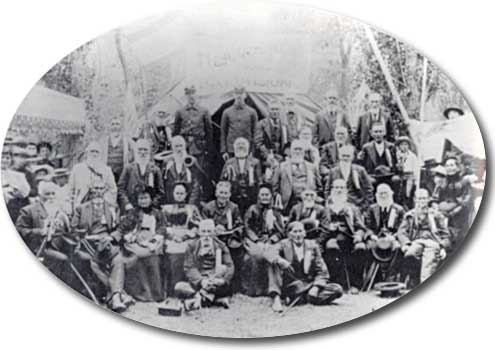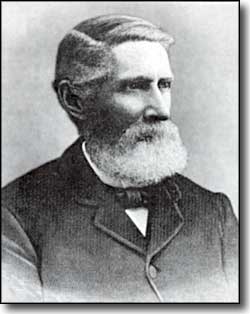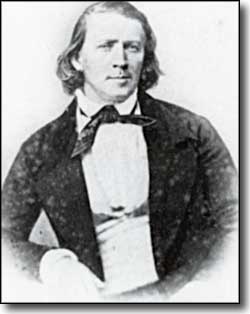 |
The Mormon Battalion |
|
|
 50th Reunion of the Mormon Battalion |

On April 6, 1846, John Brown and William Crosby led a group of wagons and sixty-some men, women and children out of Greenwood Springs, Mississippi and onto the road to Utah. John Brown was a native Tennessean and Latter Day Saint missionary who had had much success in Marion County, Alabama and nearby Monroe County, Mississippi. By the time Joseph Smith was shot to death in Illinois, about 200 people had joined the church under John Brown, most of them relatives of William Crosby, an influential Mississippi farmer. They became caught up in the nationwide furor which drove every Mormon out of the United States and onto the trails leading to the Salt Lake Valley. (That's John Brown on the left) They pushed their ox teams to St. Louis and then to Independence, Missouri. Numbering almost 80 people at this point, they then headed up the Oregon Trail intent on rendezvousing with the rest of the Church members near the Platte River in central Nebraska. When they arrived there, they didn't know that the main body of the Church was in Winter Quarters 170 miles to the east. However, thinking that they were running behind the others, the group sped up and headed for Fort Laramie. They beat Brother Brigham Young by nearly a year. At Fort Laramie they learned that no other Mormons had come by yet. They didn't know what to do so when a French trapper invited them to winter near his camp 260 miles to the south, they went. Four weeks later they arrived at "Fort" Pueblo on the Arkansas River. |
|
On May 12, 1846, the United States declared war on Mexico. President James K. Polk authorized Stephen W. Kearny to receive into service as volunteers 500 of the Mormons who were already on the Mormon Trail headed west. Months before, Brigham Young had sent a letter to the President offering to build block houses and stockade forts along the trails to Oregon and California for the benefit of future travelers. As most of the members of the Church were pretty much destitute, this was a plan to provide much needed services in exchange for government compensation. On June 26, 1846, Captain James Allen rode into the makeshift Mormon camp at Mt. Pisgah, Iowa, and asked for volunteers. Brigham Young replied, " You shall have your men, and if we have not enough men we will furnish you women." They had enough men together in 3 days. This is how the Mormon Battalion began. This is the only time in American history that a religious body has been asked to supply an army unit entirely made up of its own members. On the other hand, the pay, the clothing and the supplies (which the volunteers were allowed to keep) eventually funded the Salt Lake Valley economy to the tune of $50,000 1847 dollars. 
Captain Allen moved the Battalion from Iowa to Fort Leavenworth, Kansas. Allen then died within days of arriving there. From Leavenworth, Lt. Andrew Jackson Smith took over and headed the Battalion for Santa Fe. Presumably annoyed at having to deal with Mormons, Smith continually dictated forced marches and other inequities. One chronicler of the times said that any other body of people not already used to being herded from one place to the next "would have mutinied rather than submit to the oppressions." (That's Brigham Young at 39 on the right) As this group reached the Arkansas River near Dodge City, Kansas, they encountered John Brown on his way from Pueblo back to Mississippi. Lieutenant Smith, on hearing of a comfortable group of Latter Day Saints just up the river, couldn't believe his luck. Under escort of 10 soldiers, he sent a group of ailing soldiers and most of the Mormon women and children up the river 270 miles to Pueblo. Over the next 3 months, the Army of the West would send several sick detachments to Pueblo and boost the Latter Day Saint population there to nearly 300 by November. In The Oregon Trail, Francis Parkman described his arrival at Pueblo in those days: "After half an hour's riding we saw the white wagons of the Mormons drawn up among the trees. Axes were sounding, trees were falling and log huts going up along the edge of the woods and upon the adjoining meadow. As we came up, the Mormons left their work and seated themselves on the timber around us, when they began earnestly to discuss points of theology." |
|
In exchange for supplies, the Mormons helped the local trader/trappers to build a number of cabins to protect and buttress the inner, mud-walled fort. They built themselves a row of cabins about a half-mile away, on the south side of the Arkansas. Here they passed an unusually mild winter. The Mississippi Company probably saved the lives of the furloughed Battalioneers. And 2 days journey downstream was Bent's Fort, an American military installation where the Battalioneers could draw military provisions and occasional employment, all of which they used to help support the group at Pueblo. 500 miles to the south, that same November, 340 men, 4 officers' wives (the wives were on the payroll as laundresses but paid the same as privates), and 4-to-6 children with the Battalion turned and headed west, cutting the first wagon tracks in history across the wilderness from Deming (on the Camino Real) to Tucson to Yuma to Escondido to San Diego, reaching there on January 29, 1847. Their only armed conflict came just south of Tucson at the Battle of the Bulls: a number of wild cattle stampeded into the rear companies of the Battalion and the hunters opened fire. The final toll was "10 to 15 bulls killed, 2 mules gored to death, 3 men wounded." Ironically, this Mormon Battalion "marching half naked and half fed, and living upon wild animals, discovered and made a road of great value to our country." A country from which the main body of Latter Day Saints, huddled in dugouts and crude shelters frozen in along the banks of the Missouri River, was presently fleeing for safety (US President Martin Van Buren once told Joseph Smith, who was seeking financial redress for criminal mob actions, "Gentlemen, your cause is just, but I can do nothing for you. If I take up for you I shall lose the vote of Missouri.") April 5, 1847, the first wagons moved out of Winter Quarters and headed west. In the 10 month stay, maybe 600 people had died of cholera, influenza and exposure. Of the 12,000 others, 2,000 of them were moving west by the end of that April. The advance party followed the Platte River to Confluence Point, then followed the North Platte to Fort Laramie. Arriving there on June 2, they were greeted by the Mississippi Company who were already there. They continued westward and finally entered the Valley of the Great Salt Lake on Saturday, July 24, 1847. Over the next 22 years, nearly 70,000 Mormon pioneers would follow them. Several months after arriving in California, the Mormon Battalion was disbanded and many of the members then made their way north in California before heading east across the Sierra Nevadas and making their way to Utah. Some members of the Battalion remained in California, establishing small colonies in the south before they were recalled to Utah when it looked like the federal government and the LDS church were heading into what became known as the "Utah War," just before the American Civil War began. In honor of their efforts and their financial support of the LDS church as members of the Mormon Battalion, over the years many leaders of the Battalion were put in charge of various groups of colonists and sent out from Salt Lake City to establish colonies in Idaho, Wyoming, Colorado, Arizona, Nevada and other parts of Utah. |
|
|
 |
| Index - Arizona - Colorado - Idaho - Montana - Nevada - New Mexico - Utah - Wyoming National Forests - National Parks - Scenic Byways - Ski & Snowboard Areas - BLM Sites Wilderness Areas - National Wildlife Refuges - National Trails - Rural Life Sponsor Sangres.com - About Sangres.com - Privacy Policy - Accessibility |
| I think the black and white photos are all in the Public Domain. Text Copyright © by Sangres.com. All rights reserved. |